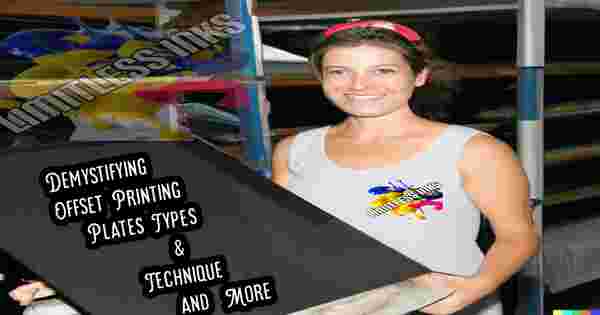Lithographic platemaking is the heart of offset-litho printing, a versatile and widely-used printing technique.
This comprehensive guide delves into the intricate world of platemaking, highlighting different plate types and their unique characteristics, as well as the fascinating processes involved.
Whether you're a printing enthusiast or a professional in the field, this article will provide you with valuable insights into the art of lithographic platemaking.
The Role of the 'Plate' in Offset Printing
In the realm of offset litho printing, the term 'plate' holds a central role. A 'plate' in offset printing refers to the crucial component that carries the image to be printed onto the paper.
These plates come in various types, each designed to cater to specific printing needs.
In this article, we will explore the diverse types of plates and delve into the unique characteristics of each, shedding light on their manufacturing processes.
This comprehensive guide aims to provide readers, whether printing enthusiasts or industry professionals, with valuable insights into the world of lithographic platemaking, helping them make informed decisions to achieve top-notch print quality and cost-effective solutions.
I. Pre-Sensitized Surface Plates
Pre-sensitized surface plates are the workhorses of offset-litho printing.
They are fabricated from various base materials, including plastic, paper, and aluminum.
Aluminum plates, in particular, undergo surface modifications like graining or anodizing to enhance their non-image properties.
These plates come with a light-sensitive coating applied by the manufacturer.
The two primary types of pre-sensitized coatings are diazo and photopolymer, available in both positive and negative variations.
A. Positive Working Plates
Positive working plates are a cornerstone in platemaking.
Their coating becomes soluble upon exposure to light, making them ideal for creating detailed and intricate images.
The process involves placing a film negative or positive onto the plate and exposing it to UV light within a vacuum frame.
Subsequently, the plate undergoes development, typically using an automatic plate processor, leaving behind ink-receptive image areas.
While producing positive working plates requires specialized equipment, they offer excellent quality and precision.
B. Negative Working Plates
In contrast, negative working plates possess a coating that becomes insoluble upon exposure to light, forming a bond with the plate base.
Developing solvents are used to remove unexposed areas, unveiling the ink-receptive image areas.
The production process parallels that of positive working plates, involving exposure, development, and plate processing.
Negative working plates are valued for their versatility and are often used in various printing applications.
II. Other Types of Plates
While pre-sensitized surface plates dominate the industry, other plate types cater to specific printing requirements.
A. Wipe-On Plates
Wipe-on plates arrive uncoated, with the light-sensitive resin coating applied by the platemaker.
They offer cost savings but have a shorter press life, making them suitable for shorter print runs.
B. Deep-Etch Plates
Deep-etch plates have an image forming layer slightly below the surface of the non-image base metal.
They are positive working plates that require longer processing times but have seen declining usage due to advancements in other plate types.
C. Multi-Metal Plates
Multi-metal plates incorporate different metals for image and non-image areas, offering high quality and extended press life.
These plates, with grease-receptive image areas and water-affinitive non-image areas, excel in long runs and repeat work.
D. Electrostatic Imaged Plates
Electrostatic imaged plates use photo-conductive materials to create images, with the coating holding an electrostatic charge until exposed to light.
These plates are capable of extensive print runs, making them suitable for applications like newspaper printing.
E. Chemical Diffusion Transfer Plates
Chemical diffusion transfer plates utilize a transfer process involving silver salts, making them suitable for text and line copy, with print runs of up to 40,000 impressions.
F. Photodirect Plates
Photodirect plates employ dimensionally stable paper impregnated with plastic and coated with a three-layer emulsion for quick and cost-effective production, ideal for short print runs.
G. Direct Image Plates
Direct image plates involve applying images directly to the plate base using various methods and are suitable for short runs.
H. Driographic Plates
Driographic plates are tailored for waterless printing, with silicone rubber coatings in non-image areas.
They offer exceptional dot sharpness and color strength but require careful handling.
Conclusion
In the realm of offset-litho printing, selecting the right plate type is crucial for achieving optimal print quality and efficiency.
Pre-sensitized surface plates, both positive and negative working, are widely used but coexist with various alternatives such as wipe-on plates, deep-etch plates, multi-metal plates, electrostatic imaged plates, chemical diffusion transfer plates, photodirect plates, direct image plates, and driographic plates.
Each plate type has its own set of advantages and limitations, catering to diverse printing needs.
By comprehending the characteristics and processes involved in lithographic platemaking, printers can make informed decisions, ensuring top-notch results and cost-effective solutions.
Explore the artistry of lithographic platemaking and elevate your printing game today.

